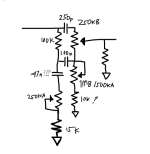hydr41n
New member
Hi Guysss!!! Does Anyone have a time to help me create a schematic for this idea? Or is this thing even gonna work 
I don't know if i get it right for this idea since I'm a still a noob and just read some documents and research. Any feedback, critics to Enlighten me is very very welcome!
This is basically the Scenario Preamp in the core.
Ideally run this on 28v > 30v
OPAMPs -> TL072 / OPA2134 *if i have the budget
JFET -> 2N5457 / J201 *if i have the budget
// === POWER SUPPLY SECTION ===
// 18V DC Input -> Boost to 30v
+18VDC_IN ---> [EMI Filter] ---> [Input Diode Protection: 1N5819] --->
[Electrolytic Cap: 470uF/50V] || [Ceramic: 100nF] --->
[TDK-Lambda I3A4W005A150V-003-R DC-DC Boost Module] or any alternative idea??
→ Set Output to +30V (via trim pin)
→ Optional LC Filter: 10uH + 220uF/35V Low ESR Output Cap
→ Clean +30VDC rail for all circuits
// === INPUT BUFFER ===
[Guitar In] ---> [OPA2134 U1A] (Buffer & Splitter)
- Main Path: U1A output → Volume Pot (100kA) → C1 (100nF)
// === EARLY GAIN STAGE ===
C1 ---> Gate of Q1 (J201 - First Gain Stage)
Drain: R4 (12k) to +30V
Source: R5 (1.5k) to GND
Gate Bias: R6 (1M) from V+, R7 (1M) to GND
Optional bypass cap C4 (2.2uF, SW1 for Custom/Flat)
Drain output ---> C2 (100nF)
// === VOICING SWITCHES ===
- SW1: Custom/Flat (Q1 bypass cap toggle)
- SW2: Bright switch (120pF across Volume pot)
- SW3: Deep switch (220nF cap before Q1)
- SW4: Q2 Bypass cap voicing toggle (2.2uF on source)
// === TONESTACK ===
C2 ---> Tone Stack Node:
- Treble: Treble Pot (250kB) → C4 (250pF) to GND
- Mid: Mid Pot (250kA) → R11 (15k) to GND
- Bass: Bass Pot (1MB) → C6 (100nF) to GND
→ Shared tone stack output through C5 (10nF)
Output of tone stack ---> C3 (100nF)
// === POST-TONESTACK BUFFER ===
C3 ---> [OPA2134 U2A] (Buffer Stage)
- Feedback: R12 (100k) in parallel with Rboost (1.5k) + Cfb (220pF)
- Input R13 (100k), +IN to GND via 100k
U2A Output ---> C8 (100nF)
// === DRIVE ===
C8 ---> Gate of Q2 (J201 - 2nd Gain Stage)
Drain: R14 (12k) to +30V
Source: R15 (1.5k) to GND
Gate Bias: 1M Reverse Audio Pot:
+30V --[1M RA Pot]-- Wiper to Gate --[100k]-- to C8, bottom to GND
Optional: Bypass cap C9 (2.2uF, SW4)
Drain output ---> C10 (100nF)
// === LOCAL NEGATIVE FEEDBACK LOOP ?????? ===
Q2 Drain ---> Rfb (220k) + Cfb (220pF) ---> Source of Q2 (R15)
// === ROTARY FILTERS ===
Q2 output (C10) ---> Filter1 (Rotary High Cut)
- 6-pos rotary caps (330pF–3.3nF)
→ R20 (100k) to GND
Then → Filter2 (Rotary Low Cut)
- 6-pos rotary caps (2.2nF–10nF)
→ R21 (10k) to GND
Output of Filter2 ---> C11 (100nF)
// === MIXING STAGE ===
C11 + Clean tap from U1A (pre-gain) ---> [OPA2134 U1B] (Summing Mixer)
- Clean path attenuated via internal trim: [50k trim pot] + [10k resistor] from U1A output ****not sure if I need a phase inverter here!!!!
- Dirt path via internal trim: [50k trim pot] + [10k resistor] from Filter2
- Feedback R18 (100k), +IN to GND via 100k
- Clean/Dirt ratio adjustable 0–100% via internal trims (default set 60:40? need to test -> clean:dirt)
// === ***OPTIONAL FILTER SECTION ***INTERNAL SWITCH===
C13 ---> SW6: Low-end rolloff <85Hz (220nF + 10k) --->
Then → SW7: High-end smoothing >6kHz (10k + 470pF) --->
// === OUTPUT DRIVER ===
→ Level Pot (100kA)
Wiper ---> [OPA2134 U2B] (Low-Z Line Driver)
- Feedback: R22 (100k) in parallel with Rboost2 (1.5k) + Cfb2 (220pF)
- Input R23 (100k), +IN to GND via 100k
U2B output ---> Output Jack
I don't know if i get it right for this idea since I'm a still a noob and just read some documents and research. Any feedback, critics to Enlighten me is very very welcome!
This is basically the Scenario Preamp in the core.
Ideally run this on 28v > 30v
OPAMPs -> TL072 / OPA2134 *if i have the budget
JFET -> 2N5457 / J201 *if i have the budget
// === POWER SUPPLY SECTION ===
// 18V DC Input -> Boost to 30v
+18VDC_IN ---> [EMI Filter] ---> [Input Diode Protection: 1N5819] --->
[Electrolytic Cap: 470uF/50V] || [Ceramic: 100nF] --->
[TDK-Lambda I3A4W005A150V-003-R DC-DC Boost Module] or any alternative idea??
→ Set Output to +30V (via trim pin)
→ Optional LC Filter: 10uH + 220uF/35V Low ESR Output Cap
→ Clean +30VDC rail for all circuits
// === INPUT BUFFER ===
[Guitar In] ---> [OPA2134 U1A] (Buffer & Splitter)
- Main Path: U1A output → Volume Pot (100kA) → C1 (100nF)
// === EARLY GAIN STAGE ===
C1 ---> Gate of Q1 (J201 - First Gain Stage)
Drain: R4 (12k) to +30V
Source: R5 (1.5k) to GND
Gate Bias: R6 (1M) from V+, R7 (1M) to GND
Optional bypass cap C4 (2.2uF, SW1 for Custom/Flat)
Drain output ---> C2 (100nF)
// === VOICING SWITCHES ===
- SW1: Custom/Flat (Q1 bypass cap toggle)
- SW2: Bright switch (120pF across Volume pot)
- SW3: Deep switch (220nF cap before Q1)
- SW4: Q2 Bypass cap voicing toggle (2.2uF on source)
// === TONESTACK ===
C2 ---> Tone Stack Node:
- Treble: Treble Pot (250kB) → C4 (250pF) to GND
- Mid: Mid Pot (250kA) → R11 (15k) to GND
- Bass: Bass Pot (1MB) → C6 (100nF) to GND
→ Shared tone stack output through C5 (10nF)
Output of tone stack ---> C3 (100nF)
// === POST-TONESTACK BUFFER ===
C3 ---> [OPA2134 U2A] (Buffer Stage)
- Feedback: R12 (100k) in parallel with Rboost (1.5k) + Cfb (220pF)
- Input R13 (100k), +IN to GND via 100k
U2A Output ---> C8 (100nF)
// === DRIVE ===
C8 ---> Gate of Q2 (J201 - 2nd Gain Stage)
Drain: R14 (12k) to +30V
Source: R15 (1.5k) to GND
Gate Bias: 1M Reverse Audio Pot:
+30V --[1M RA Pot]-- Wiper to Gate --[100k]-- to C8, bottom to GND
Optional: Bypass cap C9 (2.2uF, SW4)
Drain output ---> C10 (100nF)
// === LOCAL NEGATIVE FEEDBACK LOOP ?????? ===
Q2 Drain ---> Rfb (220k) + Cfb (220pF) ---> Source of Q2 (R15)
// === ROTARY FILTERS ===
Q2 output (C10) ---> Filter1 (Rotary High Cut)
- 6-pos rotary caps (330pF–3.3nF)
→ R20 (100k) to GND
Then → Filter2 (Rotary Low Cut)
- 6-pos rotary caps (2.2nF–10nF)
→ R21 (10k) to GND
Output of Filter2 ---> C11 (100nF)
// === MIXING STAGE ===
C11 + Clean tap from U1A (pre-gain) ---> [OPA2134 U1B] (Summing Mixer)
- Clean path attenuated via internal trim: [50k trim pot] + [10k resistor] from U1A output ****not sure if I need a phase inverter here!!!!
- Dirt path via internal trim: [50k trim pot] + [10k resistor] from Filter2
- Feedback R18 (100k), +IN to GND via 100k
- Clean/Dirt ratio adjustable 0–100% via internal trims (default set 60:40? need to test -> clean:dirt)
// === ***OPTIONAL FILTER SECTION ***INTERNAL SWITCH===
C13 ---> SW6: Low-end rolloff <85Hz (220nF + 10k) --->
Then → SW7: High-end smoothing >6kHz (10k + 470pF) --->
// === OUTPUT DRIVER ===
→ Level Pot (100kA)
Wiper ---> [OPA2134 U2B] (Low-Z Line Driver)
- Feedback: R22 (100k) in parallel with Rboost2 (1.5k) + Cfb2 (220pF)
- Input R23 (100k), +IN to GND via 100k
U2B output ---> Output Jack
Last edited:


